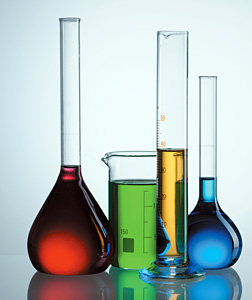No one can deny that industrialization has created quite a few conveniences. But with these modern-day conveniences have come modern-day health hazards – the worst being those that are potentially toxic to ourselves and our children.
Off-Gassing
This word was first used in 1966 to describe the release of gaseous chemicals from a solid. For instance, the Construction Dictionary defines "off-gassing" as the release of airborne particulates, often from installed construction materials such as carpeting, cabinetry, or paint that can cause allergic reactions and other health problems in building occupants. Off-gassing, while commonly attributed to carpeting, can be caused by several unexpected sources.1 The top 10 sources of off-gassing in order of concern include common household items / products: mattresses, stains/varnishes, carpet, insulation, flooring materials (vinyl, glues, finishes, adhesives), countertops, cabinets, particle board, paint strippers and cleaning supplies.2
The Environmental Protection Agency defines "off-gassing" as volatile organic compounds (VOCs) emitted as gases from certain solids or liquids. The typical symptoms of exposure to VOCs include eye, nose and throat irritation, headaches, nausea or vomiting, dizziness, and/or worsening of asthma symptoms. For those who have long-term exposure to VOCs there is an increased risk of cancer, liver and kidney damage or central nervous system damage.
 The elderly and very young, or anyone with a history of asthma, allergies or lung problems, will generally be more susceptible to the effects of off-gassing. With regards to the off-gassing of carpeting, flooring or other building materials, infants, toddlers and even pets may be more quickly affected due to prolonged, close proximity to the materials that are off-gassing.
The elderly and very young, or anyone with a history of asthma, allergies or lung problems, will generally be more susceptible to the effects of off-gassing. With regards to the off-gassing of carpeting, flooring or other building materials, infants, toddlers and even pets may be more quickly affected due to prolonged, close proximity to the materials that are off-gassing.
Mattresses
Petroleum-based chemicals are used in some foam mattresses, and synthetic fabrics are treated with chemical fire retardants. Mattresses and bedding made using these particular chemicals can potentially cause reactions in people with chemical sensitivities. The majority of these chemicals have not been tested on young children and have rarely been tested for long-term exposure.
Dr. Jim Sprott, a New Zealand scientist and chemist, has studied the possibility of a relationship between off-gassing baby mattresses and SIDS.3 Chemical compounds containing phosphorus, arsenic and antimony have been added to mattresses as fire retardants and for other purposes since the early 1950s.
For the concerned consumer, there are actually many good choices for non-off-gassing mattresses, but it's important to research for a knowledgeable retailer. One should not assume that the average salesperson has been trained appropriately or has optional products to offer. For those without a latex allergy, many memory foam mattresses made with latex are gas and chemical free; however, it should be specified that they are chemical free. Not all memory foam mattresses are the same.
Others might consider a 100 percent organic cotton mattress that are made intentionally without chemicals and are not treated with chemicals at the factory. For those concerned about the firmness of a typical cotton mattress, consider a pure wool or rubber mattress topper.4-5
"Green" Light Bulbs
Highly efficient fluorescent light bulbs are supposedly environmentally friendly, but this is one of those times when "going green" comes with a caution. These bulbs contain mercury and are not supposed to be disposed of in the garbage, but instead at an approved recycling facility or a toxic waste dump. If these bulbs are going to be thrown in the trash (because approved facilities are rare and may not be available in your community), they are to be sealed and double-wrapped in plastic bags.
"They're very efficient, but once they're used up they become a ticking toxic time bomb," said Leonard Robinson, chief deputy director of the California Department of Toxic Substances Control, in an article published in July 2007.6 He added that they need to be "captured and recycled" – but what average person knows this? More often than not they end up in a local landfill, where the chemicals eventually may leak into the soil and water.
The major concern arises when these bulbs break, releasing a toxic gas. In this case, it is suggested that everyone should leave the house, and ventilating the room for at least one hour. Carefully clean up the pieces of glass without actually touching them, seal them in a plastic bag and then take them to a toxic waste dump.
In a study published last year,7 German scientists discovered that these particular types of bulbs actually off-gas an invisible toxic haze and, therefore, should not be used close to your head or in an unventilated room. Peter Braun, from Berlin's Alab Laboratory, who led the study, determined that several gasses are emitted when the lights were switched on, including phenol, naphthalene and styrene. These are carcinogenic toxins.
Take-Home Points
The likelihood of VOCs in our patients' homes causing health problems varies widely based on what actual chemicals are off-gassing from a particular product. Yet, regardless of whether we know the VOCs involved, there are things you can recommend to protect your patients and their families. In addition to the above considerations, recommend purchasing organic and holistic cleaners, and using caution when purchasing new products. With anything that falls under the category of an item that could off-gas, recommend that your patients purchase these items during cool to moderate weather, allowing their homes to be open for proper ventilation.
References
- "Volatile Organic Compounds in Your Home." Minnesota Department of Healt.
- "20 Off-Gassing Culprits" (CalFinder.com, online post)
- Sprott TJ. "Cot Death - Cause and Prevention. Experiences in New Zealand 1995-2004" (special report). J Nutr Envir Med, Sept 2004;14(3):221-32.
- Chamberlin C. "10 Steps to an Organic Bedroom." TheCleanBedroom.com (originally published on Organic.com, January 2006).
- "Prevent Toxic Off-Gassing When You Can't Afford to Buy an Organic Mattress." Published on HealthyChild.com.
- A. Thompson. "‘Green' Light Bulbs Pack Toxic Ingredient." LiveScience.com, July 9, 2007.
- Ward V. "Energy-Saving Light Bulbs ‘Contain Cancer-Causing Chemicals.'" London Daily Telegraph, April 20, 2011.
Click here for previous articles by Claudia Anrig, DC.





